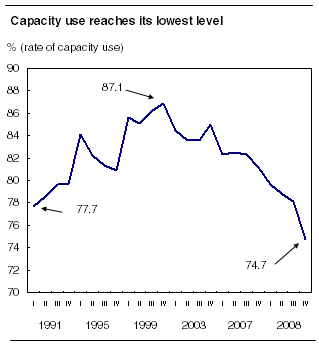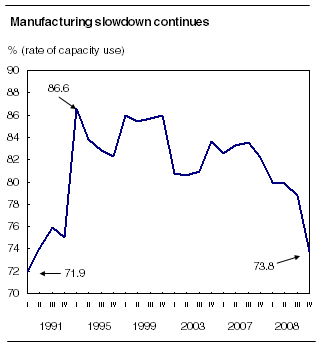Common menu bar links
Industrial capacity utilization rates
Archived Content
Information identified as archived is provided for reference, research or recordkeeping purposes. It is not subject to the Government of Canada Web Standards and has not been altered or updated since it was archived. Please "contact us" to request a format other than those available.
Canadian industries operated at 74.7% of their capacity in the fourth quarter of 2008, down from 78.1% in the third quarter. This was the lowest capacity utilization rate since the start of the data series in 1987.
The fourth-quarter decline was driven mainly by weak domestic and foreign demand for manufactured goods. Combined, three industries (transportation equipment manufacturing, construction and primary metal manufacturing) accounted for more than half of the decline.
Chart 1

Rates fell in 16 of the 21 major industries, notably manufacturing, construction, mining and oil and gas extraction, as well as electric power generation, transmission and distribution. In the non-manufacturing group, only the forestry and logging sector posted a moderate increase.
For 2008 as a whole, the annual industrial capacity utilization rate fell from 82.1% in 2007 to 77.8%, the lowest rate ever on record. The previous record low had been registered in 1992.
On an annual basis, the manufacturing sector reduced its use of production capacity by 4.8 percentage points from 2007 to 78.1% in 2008. Capacity use in the transportation equipment manufacturing industry fell by 17.5 percentage points during the year to 69.3%.
Transportation equipment and primary metal pull manufacturing sector down
Manufacturers reduced their production capacity utilization in the fourth quarter and operated at 73.8%, down from 78.8% in the third quarter. A significant cutback in production among the majority of manufacturers led to the overall reduction in capacity. Transportation equipment manufacturing and primary metal manufacturing were the main contributors to the decrease.
Note to readers
The industrial capacity utilization rate is the ratio of an industry's actual output to its estimated potential output.
For this release, rates have been revised back to the first quarter of 2006 to reflect the revised source data.
In the transportation equipment manufacturing industry, production declined 10.3% in the fourth quarter. As a result, the capacity utilization rate in this industry fell from 68.4% in the third quarter to 58.1% in the fourth quarter, the lowest rate on record. Manufacturers of motor vehicle and associated parts, who accounted for two-thirds of total output in the transportation equipment manufacturing industry, recorded declining demand from assembly plants. Some motor vehicle manufacturers were temporarily shut down during December.
Chart 2

Manufacturers of plastics and rubber products reduced their capacity use to 69.3%, also reflecting the cutback in motor vehicle manufacturing production.
Capacity use in the primary metal manufacturing industry declined 10.4 percentage points to 85.4% in the fourth quarter. This was due largely to a 23.8% reduction in the output of iron and steel manufacturing.
Capacity use in the chemical manufacturing industry declined to 77.0%. A moderate rise in production by the manufacturers of pharmaceutical products and medicine was not sufficient to offset a reduction by manufacturers of basic chemicals, resin, synthetic rubber, pesticide and fertilizer.
The capacity utilization rate in the paper manufacturing industry fell to 81.2%. Lower production at pulp and paper mills resulting from a weak export market was behind this reduction.
The machinery manufacturing industry operated at 82.1% of its capacity in the fourth quarter, down 3.5 percentage points. Declining output in the construction, mining and industrial machinery industries was behind the drop.
Only forestry and logging post increase in non-manufacturing group
Capacity use declined in all the other sectors except the forestry and logging sector, where the rate rose by 2.4 percentage points in the fourth quarter to 73.5%. This increase reflected a slight growth in output.
The mining sector, excluding oil and gas extraction, operated at 69.8% of its capacity, a slight drop from the third quarter. Lower production in metal ore, non-metal mines and coal mining explains the decrease.
In the oil and gas extraction sector, capacity use fell slightly to 76.9% in the fourth quarter, due to lower activity in petroleum and natural gas extraction.
In the construction sector, capacity use continued the downward trend started in the first quarter of 2006, falling to 74.4% in the fourth quarter, as production declined 1.2%.
Capacity use in the electric power generation, transmission and distribution sector decreased to 82.5% in response to falling domestic demand.
Available on CANSIM: table 028-0002.
Definitions, data sources and methods: survey number 2821.
Data on industrial capacity utilization rates for the first quarter of 2009 will be released on June 11.
For more information, or to enquire about the concepts, methods or data quality of this release, contact Xiang Zhou (613-951-0457; xiang.zhou@statcan.gc.ca), Investment and Capital Stock Division.
Table 1
| Third quarter 2008r | Fourth quarter 2008 | Third quarter to fourth quarter 2008 | 2007r | 2008 | 2007 to 2008 | |
|---|---|---|---|---|---|---|
| Annual average | ||||||
| % | percentage point change | % | percentage point change | |||
| Total industrial | 78.1 | 74.7 | -3.4 | 82.1 | 77.8 | -4.3 |
| Forestry and logging | 71.1 | 73.5 | 2.4 | 80.9 | 74.6 | -6.3 |
| Mining and oil and gas extraction | 75.5 | 74.7 | -1.1 | 79.2 | 75.4 | -3.8 |
| Oil and gas extraction | 77.3 | 76.9 | -0.4 | 80.2 | 77.4 | -2.8 |
| Mining | 72.4 | 69.8 | -2.6 | 76.3 | 70.8 | -5.5 |
| Electric power generation, transmission and distribution | 85.2 | 82.5 | -2.7 | 88.9 | 85.4 | -3.5 |
| Construction | 76.6 | 74.4 | -2.2 | 80.3 | 76.7 | -3.6 |
| Manufacturing | 78.8 | 73.8 | -5.0 | 82.9 | 78.1 | -4.8 |
| Food | 81.4 | 79.3 | -2.1 | 80.1 | 81.0 | 0.9 |
| Beverage and tobacco products | 70.6 | 72.7 | 2.1 | 71.5 | 69.9 | -1.6 |
| Beverage | 71.2 | 74.0 | 2.8 | 72.6 | 70.3 | -2.3 |
| Tobacco | 66.6 | 64.8 | -1.8 | 65.2 | 67.0 | 1.8 |
| Textile mills | 65.9 | 67.5 | 1.6 | 69.5 | 65.5 | -4.0 |
| Textile product mills | 78.9 | 76.1 | -2.8 | 81.5 | 79.6 | -1.9 |
| Clothing | 68.9 | 70.0 | 1.1 | 76.0 | 68.9 | -7.1 |
| Leather and allied products | 70.2 | 78.1 | 7.9 | 77.8 | 73.8 | -4.0 |
| Wood products | 72.2 | 69.3 | -2.9 | 79.0 | 71.6 | -7.4 |
| Paper | 86.8 | 81.2 | -5.6 | 87.4 | 84.8 | -2.6 |
| Printing and related support activities | 73.0 | 71.2 | -1.8 | 73.5 | 73.0 | -0.5 |
| Petroleum and coal products | 81.0 | 78.7 | -2.3 | 82.5 | 80.8 | -1.7 |
| Chemical | 82.8 | 77.0 | -5.8 | 82.0 | 81.0 | -1.0 |
| Plastics and rubber products | 74.0 | 69.3 | -4.7 | 76.6 | 74.1 | -2.5 |
| Plastic products | 73.0 | 67.9 | -5.1 | 75.1 | 72.9 | -2.2 |
| Rubber products | 78.8 | 75.9 | -2.9 | 83.9 | 79.6 | -4.3 |
| Non-metallic mineral products | 84.5 | 78.9 | -5.6 | 85.0 | 81.4 | -3.6 |
| Primary metal | 95.8 | 85.4 | -10.4 | 92.1 | 91.5 | -0.6 |
| Fabricated metal products | 80.6 | 77.8 | -2.8 | 86.0 | 81.2 | -4.8 |
| Machinery | 85.6 | 82.1 | -3.5 | 83.5 | 84.7 | 1.2 |
| Computer and electronic products | 87.7 | 85.9 | -1.8 | 88.1 | 87.5 | -0.6 |
| Electrical equipment, appliances and components | 83.9 | 85.5 | 1.6 | 83.6 | 83.0 | -0.6 |
| Transportation equipment | 68.4 | 58.1 | -10.3 | 86.8 | 69.3 | -17.5 |
| Furniture and related products | 77.8 | 74.9 | -2.9 | 81.2 | 77.1 | -4.1 |
| Miscellaneous manufacturing | 80.2 | 77.8 | -2.4 | 77.3 | 78.2 | 0.9 |

